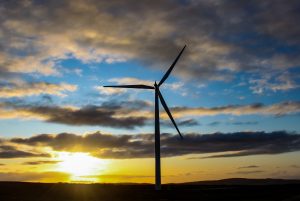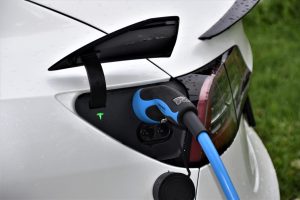This is the third in a series of blog posts with our colleagues at Urban Economic exploring how we can recover the economy to build a green and smart society. We open the conversation in:
- The Green Recovery Opportunity
- How connectivity, data and digital enables a sustainable recovery and growth
- The sustainable energy opportunity.
- The market opportunity for sustainable mobility
- Financing green recovery initiatives
This week we will discuss the sustainable energy opportunity in the UK.

The Sustainable Energy Opportunity
There are a few things humans need as a basic necessity. Maslow’s hierarchy summarises this neatly – we require the basics met before we can attend to ‘higher order’ needs such as psychological needs and self-actualisation needs. Energy is one such “basic” and one of the most in-demand and unseen needs we have as a society. It is power for production and transport, warmth for our homes, and facilitates and delivers our entertainment. We expect our houses to have water and electricity at a minimum. We expect our shops, factories and schools to have power and plumbing as well.
We don’t have a love-hate relationship with energy; we have an indifference to it (unless there is a supply issue – then, everyone notices it). No one says anything when the lights are running ‘as normal’. Everyone complains when they unexpectedly shut off. A lot of the time we have no idea where energy comes from or what was done to produce it. As long as it is there, we don’t seem to care.
We should.
Energy emissions contribute significantly to the carbon footprint of our current system. They underlie a great deal of what we do and have a proportionate impact on our ability to meet our net-zero goals. A ‘dirty’ energy system will add a significant amount to our national carbon footprint. By the same token, a ‘clean’ one will help a lot.
The Challenge
We need to transform our energy system if we are to meet net zero carbon promises and commitments as a nation. At the same time society faces challenges around transportation, future of high streets, schools and skills and rebuilding and restarting the local economy. What if these were not mutually exclusive but a coherent co-operation? Can we look at this challenge as one of up-levelling regions, and now with COVID19 recovery, rebuilding into something new?
A joined-up national plan of decarbonisation is emerging around the renewable energy sources the UK is abundant in. On Monday 14 December 2020, the government published its long-awaited Energy White Paper ‘Powering our Net Zero Future’. The White Paper sets out a high level strategy for how the UK will:
- build a green, cleaner future
- create thousands of new green jobs
- cut bills, protect the fuel poor and create warmer, more comfortable homes.
Decarbonising the energy system is a major focus of the White Paper, replacing fossil fuels with clean energy technologies such as renewables, nuclear and hydrogen. Clean electricity is predicted to become the predominant form of energy, with electricity demand expected to double by 2050.
Alongside this, the Green Industrial Revolution announced in November 2020 includes commitments to mobilise £12bn in funds. The promise to develop more offshore wind (supply) and electric vehicles (demand) will stimulate investment in skills and jobs in the low carbon economy. Hydrogen is being viewed as a stepping stone from natural gas use for heating and cooking; homes and buildings are being treated to reduce demand for energy to heat them properly; and there is a push to plan for low carbon forms of public transportation and walking. There is also a commitment to nature, protecting and restoring our environment.
Meanwhile, the Grid has to prepare itself for large sources of renewable energy. It has seen what more flexible and at home working means for the way we transmit and purchase power. During the pandemic our national demand fell low enough that we could have used purely renewables – however due to the asynchronous nature of the energy produced, the National Grid had to spend £593-725m purely on Balancing Services to support the Grid. The regional Distribution System Operators (previously District Network Operators) have plans for a smart grid that will ‘allow’ renewable energy to feature heavily, but they are also distracted and slowed by business as usual.
Places with net zero carbon commitments are left in limbo, unable to move without support from the DSO, feeling like they have no leverage to enact faster change, whilst beholden to voters who appreciate the Climate Emergency and want more visible action that will deliver tangible results.
We need to bring energy into the national conversation as an opportunity rather than an afterthought or a necessary evil.
Energising the nation
The UK’s renewable energy production could revolutionise skills and industry as well as carbon emissions and cleaner air.
Cleaner air and quieter roads
The main idea is that by focusing on forces of nature that have abundant kinetic energy such that putting a device in the flow would not disrupt natural processes, we will produce energy with little raw material needs. That isn’t completely true; wind turbines are large engineered structures with various parts that need maintenance and replacement, but this is also the case with a coal-fired or biomass-burning power station. The energy from a wind turbine is associated with minimal processing and with little by-products or waste (especially compared to a traditional fuelled power station). That means there are less localised impacts as well. Thermal combustion power stations have local air quality impacts and traffic impacts from delivery of raw materials and removal of waste. Eliminating the need to process ‘things’ to get energy removes those impacts.
In terms of electric vehicles there are no tailpipe emissions, so we can expect a reduced air quality impact. We are still facing a particulate matter (PM) problem, as tyres and brakes will release small particles into the air, especially at junctions. EVs also do not address congestion issues. We will need smart transport solutions for that.
Skills and industry
Excitingly, without the need for raw materials tying us to the location of those raw materials, we can develop home-grown engineering and technical skills anywhere in the UK and sell anywhere in the world. It is time for a rebalancing of economic and social opportunities and a more equitable distribution of services and quality of life across the UK. Along with digital and technology, skills associated with environmental engineering and renewable energy manufacturing and maintenance represent that opportunity.
EVs, however, rely on rare earth metals in the batteries. Deposits such as lithium are limited in the world; rare earth metals is in the name. The UK Government has identified the development of current and future generations of battery technology of strategic importance to the UKs manufacturing sector and key to sustaining our valuable domestic automotive industry. BritishVolt has ambitions to lead the ‘beyond lithium ion battery’ industry (with plans for the gigafactory to be built first in South Wales and now looking to be the North-East. Regardless, with a name like BritishVolt, they are sure be onshored).
Fuel poverty
The White Paper confirms that a Fuel Poverty Strategy for England will be published next year but in the meantime, the national push toward offshore wind is touted to lower costs and result in cheaper energy. Without (potentially volatile) raw material costs, energy prices can be a lot more stable and bankable. As well, small local energy systems (SLES) are growing in importance to organisations looking to be in control of both prices and carbon emissions of the energy used by residents or businesses. This is particularly relevant for those in danger of fuel poverty. The latest figures for England show that in 2018, the number of households in fuel poverty was estimated at 2.4 million, representing just under 11% of all English households. England uses the Low Income High Costs definition to measure fuel poverty. National Energy Action, which campaigns to end fuel poverty, estimates 12,000 people die each year from health conditions arising or worsening from having a cold home.
Homes and their impact
Some housing associations and developers are moving into the ‘home grown energy’ space. Becoming an energy company is not that far of a stretch – it is another service that people expect, and centralised management of energy can help promote efficiencies (up to a certain scale – too big and we lose energy in transmission and conversion losses; too small and the microgrid is not stable enough). The sweet spot seems to be community-level.
Digitalisation comes with the promise of operational savings through to complete transformation of delivery of services. There are a few key trends to keep in mind from the Internet of Things (IoT) world to reduce the housing sector’s impact on the environment.
Primary savings are usually from reduced or avoided energy consumption in operations, whether from gas or electricity. IoT can help in homes through sensors for monitoring boilers, checking temperatures, and detecting damp, through to actuating changes such as turning the heating on or off.
Boiler monitoring saves cost through more efficient use of energy (using less of it to produce the same amount of heat, saving cost; flagging the need for preventative maintenance saving more expensive and invasive fixes and preventing down time). This can also help to address fuel poverty.
Actuating or acting on information is the next step in smart technology and represents an exciting opportunity for housing management. For example, a central control system could deliver the heat required by the household with no waste. Sero Homes has a vision for ‘Hassle Free Homes’, where they take responsibility for delivering low carbon heat when customers request it, controlling the amount (and price) of heat and electricity.
Once large datasets are collated (sensitively) AI and Machine Learning (ML) can be used to sift through trends and analyses. Deep Mind, Google’s AI, saved 40% of the cooling bill at Google’s data centres using this approach. Energy use at home can point to trends in a person’s wellness, and point out any irregularities quickly, helping predict a fall in the elderly. These IoT applications will need to be handled correctly, bringing participants on board and in an inclusive way.
The Royal Society sees great potential in digital technologies to be applied to societal problems including environmental impact; the key is to use these appropriately.
Conclusion
The opportunities are clear and exciting. While the government can provide investment and the right policy framework, it is industry and providers that need to implement that change. This will be hastened by customer demand. That’s why we should all pay a bit more attention to the invisible energy that we use and consume, make it prominent and part of our strategy for changing to a better, cleaner world. Local air quality impacts are not to be ignored; by moving to sustainable energy, we reduce costs in terms of money and in terms of lives.
Next week the blog series will be hosted on Urban Economic’s website.
Urban Economic and Perform Green are teaming up to work on maximising economic recovery and increasing regional prosperity in the post pandemic environment. We will present our latest thinking explored in the recent white paper from Urban Economic: The Air that we Breathe: A playbook for the Urban Post Pandemic Environment. We will explore 3 strategic pillars to maximise economic and social returns:
- Green Infrastructure
- Energy Efficiency
- Digitisation
In the post-pandemic environment now, more than ever, city and regional leaders need to maximise their growth potential and be confident that the strategies and solutions they apply have a high and measurable return on investment. Recovery requires broad-based fiscal stimulus and strategic investment: jobs need to be created and new areas of growth identified and pursued.
The governments that choose to implement a sustainable post-pandemic recovery will become the benchmark for cities of the future, reaping the gains of early investment through a stronger economy and a healthier society.


